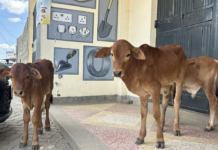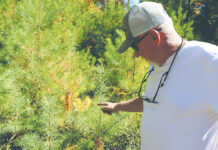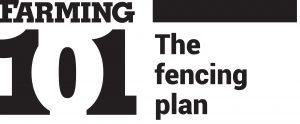Fencing is a costly investment, but an important one for farmers with livestock. Planning is key to making sure fencing is installed properly and getting the most out of the investment.
1Map it out
Make a sketch of your farm, taking waterways and the topography of the land into account — the location and arrangement could affect production efficiency. Divide land into areas best suited for permanent pastures or hay, woodlands not to be pasture, woodlands that can be pastured, and land for crops.
2Locate lanes and gates
Ideally, a lane should connect livestock buildings, working facilities and water with every field that may eventually be pastured. A permanent pasture located between other fields can serve as a lane.Locate lanes in the driest areas possible, such as along a terrace or natural ridge,
Locate lanes in the driest areas possible, such as along a terrace or natural ridge, otherwise gullies may form after repeated use. If a well-drained location is impossible, plan on a movable lane. If lanes are used frequently, consider grading the area and graveling.
Locate gates and passageways for livestock and equipment in the corner of each field closest to farm buildings. If fields are located across a roadway, position gates opposite each other so livestock can go directly across.
3Permanent fencing
Permanent fencing should be well constructed from high quality material to last with minimum repairs. Permanent fencing should be used around the perimeter of the farm to establish a fixed property line and prevent livestock from escaping. If entire boundary fencing is not affordable, then install what is necessary to contain livestock.
Also, consider permanent fencing around pastures that will be used year after year, and around cropland. These fences will most likely never be moved, so it makes sense to build a well-constructed, low maintenance fence.
4Temporary fences
Movable fences are considered temporary fences and are normally used for a short period of time before being moved to a new location. They are easy to build and take down and cost less, but they typically will not last as long as permanent fences.
These fences are suited for controlled and rotational grazing situations and for dividing pastures to suit the needs of the livestock. They can be moved from year to year until you decide the field layout that works best and they can be used temporarily in place of a permanent fence until you can afford permanent fencing.
Sources: University of Georgia Cooperative Extension and University of Tennessee Institute of Agriculture.
Next week: Farm and Dairy will provide additional tips on choosing the proper fence.
(Farm and Dairy is featuring a series of “101” columns throughout the year to help young and beginning farmers master farm living. From finances to management to machinery repair and animal care, farmers do it all.)
More Farming 101 columns:
- 7 steps for easy sprayer calibration
- Prepare for planting season, Part 2: Calibration
- Prepare for planting season, Part 1: The Basics
- 7 tips to improve security on your farm
- 5 tips to protect your farmland
- 3 measures to deal with severe farm debt
- How to buy time to catch up on farm debt
- 6 tips to manage income on the farm
- 5 tips to recognize and deal with farm stress
- How to prepare a livestock birthing kit
- 5 tips for marketing your farm
- How to develop farm mission, vision statements
- 5 tips for setting farm goals
- 2 types of livestock insurance policies
- 6 things you need to know about WFRP plans
- 3 basics of crop insurance
- How does liability insurance work on the farm?
- Why do I need farm insurance?
- How to understand and use Ohio’s CAUV
- How to utilize the Pa. Clean and Green Act
- 9 tips for filing farm taxes
- 8 reasons record keeping for taxes is essential
- 5 tips for post-harvest storage
- 7 tips for family meetings on the farm
- 4 tips for balancing your farm and family
- 4 tips for communicating on the family farm
- 4 tips for firing an employee
- 6 tips for keeping good farm help
- 4 tips for recruiting farm labor
- 5 general farm labor laws
- 4 tips for employing minors
- 4 tips for PTO safety
- 5 things young farmers should know about finances
- The farm balance sheet
- 5 items for your farm’s cash flow statement
- Personal and business records: Keep them separate
- What to include in your farm business plan
- How to approach a lender: Tips for getting a farm loan
- How to use microloans to get your farm started
- Saving for the future: 6 tips for young farmers
- How to create a farm safety kit
- 5 tips for child safety on the farm
- 4 tips for transporting livestock
- 5 ways to better understand tractor stability
- 6 farm equipment hacks













Thanks for your tips on how to plan out my farm fencing. My husband and I just moved out to the country and we’re planning on starting a farm together, this article will be really helpful. I love your point about how you should make sure to build lanes along terraces so that they can last longer. I’ll have to do some landscaping around the place to accommodate for that so that once we hire a fencing company to help us build around the place it will be much easier to do so.